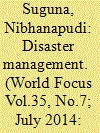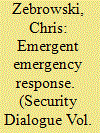|
|
|
Sort Order |
|
|
|
Items / Page
|
|
|
|
|
|
|
| Srl | Item |
| 1 |
ID:
137418


|
|
|
|
|
| Summary/Abstract |
Noting that European Union (EU) institutions are increasingly engaged in civil protection in the member states, security governance is used as an analytical framework to assess the depth of EU engagement in delivering civil security. It is shown that a state-centric approach is no longer adequate to understand the provision of civil security across Europe. To varying degrees, the EU has acquired responsibilities to facilitate, coordinate, manage, and regulate civil security, whether before or after a civil crisis occurs. The analysis demonstrates that, whilst intergovernmental practices and inter-state cooperation remain salient features of civil security, the responsibilities undertaken by the EU institutions across the entire policy spectrum are more substantial than a strictly intergovernmental perspective would suggest.
|
|
|
|
|
|
|
|
|
|
|
|
|
|
|
|
| 2 |
ID:
132495


|
|
|
|
|
| Publication |
2014.
|
| Summary/Abstract |
Each day, natural disasters such as ?oods, earthquakes and hurricanes/ cyclones threaten human life and cause severe environmental losses around the world. During the last decade, disasters have affected the lives and assets of almost 2.4 billion people across the world (OCHO, 2010). In India alone since the year 2000, an average 65 million people have been affected by disasters every year. Of this, 8.45 million have been children under the age of ?ve and 3.25 million are pregnant and lactating mothers (UNICEF). Such
humanitarian crises often set back the developmental gains of lesser developed regions by several" decades. Not only do disasters lead to the loss of life and property, but "the immediate a?ermath is a complex situation complicated by issues of logistics, search and rescue, relief distribution, limited accessibility to some of the affected areas, the threat of secondary disasters, the mostly well-intentioned interests of diverse stakeholder groups (which many a times are external to the context of thedisaster), the in?ow of aid material and grants, political interest, media interest and often limited administration capacity. Government is responsible for administrative arrangements dealing with disasters.- Effective policies play a vital role in mitigating the impact of disasters and reducing likely losses of life and property ( Erramilli, 2008) . The disaster management, which is not being treated as a sector by itself, is
undergoing major changes, especially at the institutional and policy levels, which are prompted by various. macro-level factors ( Wagle and Warghade, 2006). Effective coordination among various stakeholders, specifically the Government, the international community and nongovernmental organizations (NGOS) in the aftermath of a disaster is critical to, among other things, a minimization in disaster response time, the proper allocation of resources and the avoidance of duplication of response efforts; Moreover, as economic growth and sustainable development are essential to successful disaster preparedness and mitigation efforts, effective coordination has the potential to strengthen the link between emergency response, preparedness and long-term development strategies.
|
|
|
|
|
|
|
|
|
|
|
|
|
|
|
|
| 3 |
ID:
076775


|
|
|
|
|
| Publication |
2007.
|
| Summary/Abstract |
In the aftermath of September 11, 2001 and Hurricane Katrina, the United States government has spent tens of billions of dollars to improve the nation's ability to respond to a natural disaster or terrorist attack, but the emphasis on immediate first response has left many long-term environmental, political, and technological challenges unaddressed. Although a dirty bomb attack is unlikely to yield the same amount of physical devastation and death as caused by Katrina or a nuclear weapon, the social, psychological, and economic impact would be enormous. At present, however, the United States lacks the technology necessary to decontaminate a large, densely populated urban area under time, political, and economic constraints. This article reviews past cleanup experiences and current decontamination capabilities to consider the long-term implications of a dirty bomb, identifies weaknesses in America's existing response capabilities, notes possible areas of political friction, and considers the implications of the failure to adequately prepare. Having the appropriate decontamination techniques established and long-term plans in place before an incident occurs will significantly improve the government's ability to protect public and environmental security, establish a viable decontamination strategy, allow residents to return to their homes, and get the local economy back on its feet.
|
|
|
|
|
|
|
|
|
|
|
|
|
|
|
|
| 4 |
ID:
132497


|
|
|
|
|
| Publication |
2014.
|
| Summary/Abstract |
Hundreds of Natural disasters take place worldwide every year causing irreparable damage to life and property. Earthquakes, ?oods, typhoons, hurricanes,- Tsunamis are among the worst of these natural disasters. Over the last few decades, there has been an alarming increase in the occurrence of natural disasters and the magnitude of their social, economic and environmental impact. During any natural disaster it is usually the" children who suffer the most. The nation witnessed the death of nearly a thousand children during the 2001 Bhuj earthquake. Out of them, 300 died while marching for the Republic day parade. They were in a narrow lane when the earthquake hit causing buildings onboth sides to collapse. It is said thatpnearly 1,884 school buildings collapsed leading to a loss of 5,950 class rooms. About 12000 schools suffered damages making them un?t for children to continue their studies. Fire tragedies, like the one in Kurnbakonam killed 93 children in a school. Another ?re accident in Dabwali, Haryana where a ?re broke out during a schoolfunction took he lives of many school children. Children in schools are the 'most vulnerable group during any disaster. These tragedies reiterate the need for all of us to sit up and think about the safety of these children. It is necessary to make schools safe and hazard proof. For this purpose, it is important to have disaster management, emergency preparedness and response plans at school level.
|
|
|
|
|
|
|
|
|
|
|
|
|
|
|
|
| 5 |
ID:
165016


|
|
|
|
|
| Summary/Abstract |
Emergency responses are premised on the hope that, even when events cannot be wholly predicted and prevented, timely action in the present can be exercised to strip an emergent event of its disruptive potential. Yet, while the speed of emergency responses plays a critical role in underpinning UK resilience, it has been a relatively neglected subject in studies of resilience advanced through the paradigm of preparedness. This article aims to contribute to and extend work in the field of emergency governance by arguing that concerns surrounding the speed of response contribute to a distinct form of security enacted in contemporary emergency response strategies, which I term ‘event suppression’. Drawing on policy analysis, preparedness exercise observations and practitioner interviews, this article investigates how speed operates as a core problematic informing the design of UK emergency responses, organized through the Integrated Emergency Management framework. Integrated Emergency Management promises to accelerate emergency response operations by utilizing advances in communications technologies to drive the bottom-up emergent self-organization of emergency responses. Event suppression ensures security not by preventing an event from happening, but by quickly closing down the ‘disruptive’ time of the emergency event and restoring the linear historical time of standard political processes.
|
|
|
|
|
|
|
|
|
|
|
|
|
|
|
|
| 6 |
ID:
140038


|
|
|
|
|
| Publication |
London, Idea Group Publishing, 2000.
|
| Description |
276p.pbk
|
| Standard Number |
1878289810
|
|
|
|
|
|
|
|
|
|
|
|
Copies: C:1/I:0,R:0,Q:0
Circulation
| Accession# | Call# | Current Location | Status | Policy | Location |
| 045912 | 658.478/HIA 045912 | Main | On Shelf | General | |
|
|
|
|
| 7 |
ID:
190406


|
|
|
|
|
| Summary/Abstract |
Recent reforms to China's People's Armed Police have changed the balance of authority between central and local officials, continuing a pattern of reduced local control and granting more authority to Xi Jinping in his role as Central Military Commission chairman. The new system, however, attempts to balance central control with provisions that allow local officials down to the prefecture level to take command in some circumstances. This system intends to allow for rapid mobilization in cases of social unrest or natural disasters, although a review of emergency response plans and other Chinese sources indicates uneven implementation. The risk is that centralization could slow emergency response, although the effects will depend on the nature of civil–military coordination at different levels. The paper describes new legal authorities, assesses implementation and challenges, and reaches conclusions about the implications for Chinese political control and emergency response.
|
|
|
|
|
|
|
|
|
|
|
|
|
|
|
|
|
|
|
|
|